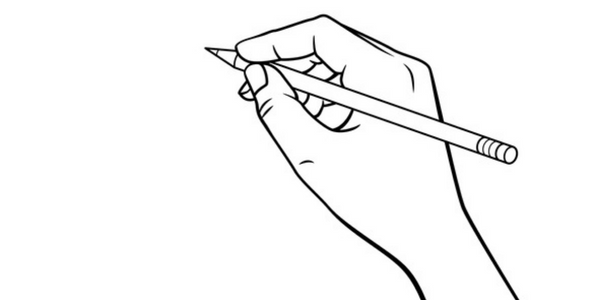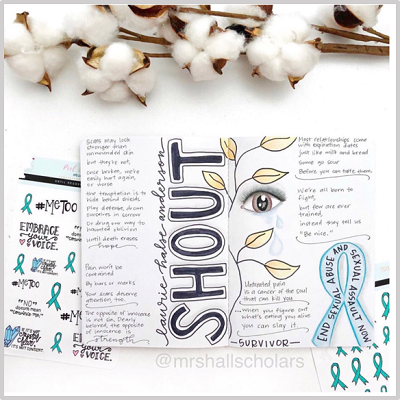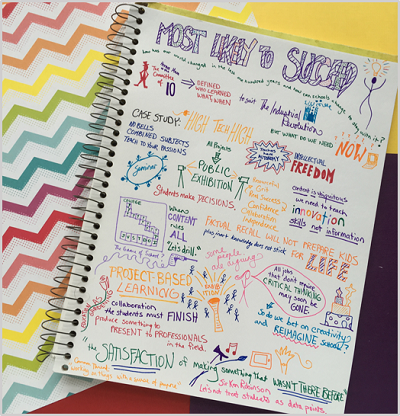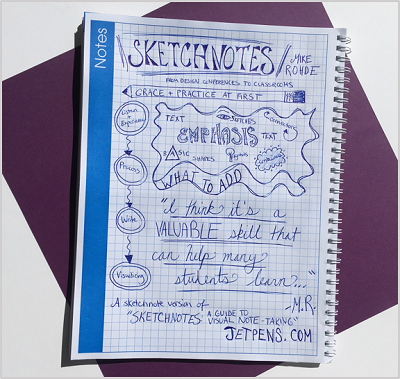

BLOGS > MARCH 31, 2020
BY BETSY POTASH

Few people would argue that taking notes is one of the great joys of being a student. Taking good notes can be a huge asset in academic life, yet it’s generally viewed as a tedious process, perfected by a few students while the rest scrape along as best they can.
Personally, I feel the same way about lectures. At times it might be necessary, but give me a project, mock trial, lab, collaborative artistic production, poetry slam or just about anything else and I’ll be much happier as a teacher.
Yet sometimes kids need to listen while experts share information, whether it comes in the form of a lecture, podcast or a video. And if they hope to remember any of that information, well, notes will be necessary for students.
Enter sketchnotes -- the magical twist on listening that takes it from passive to active.

Years ago, a designer named Mike Rohde sat in lecture after lecture, filling up thick notebooks with careful, perfect notes. He was so good at it. He hated it.
Then, overnight he had an epiphany. What if instead of writing down everything he heard so he could go back over everything again later (if he ever actually wanted to), he did the work of processing as he listened, only capturing the big ideas that really mattered in his notes?
Suddenly, he began to enjoy the process of listening, learning and capturing the knowledge he was gaining on paper. He had time to embellish the ideas, connect big thoughts, brighten letters and words with artistry, add icons, symbols, or pictures here and there. Suddenly, he enjoyed taking notes. Suddenly, they were fun to look at. Suddenly, big ideas stood out.

Since Mike’s notes went from dull to dynamic, his vision for sketchnoting has spread across the world, from design conferences to classrooms. Just search the sketchnotes hashtag on any social media platform to see all the ways this medium is used.
But why does it work? Why do sketchnotes make taking notes fun at the same time they make information more memorable? Well, it helps us remember things when our work taps into the two different ways we process things – the visual AND the verbal. So often the work of schools trends towards writing and speaking, with visual representations of ideas relegated to textbook illustrations or the occasional timeline. Sketchnotes help students tap into both sides of their brain, and that process makes it easier to remember information.

So how can you get started with sketchnotes? You might want to show your students a visual explanation to get rolling. Mike’s got a great mini-workshop on YouTube if you’ve got the time, or you could opt for this quick and lovely introduction to visual notetaking from Sketcho Frenzy.
From there, you might want to comfort your art-fearing students that the big goal of sketchnotes is to capture “ideas, not art,” as Mike often reminds people. Though their sketchnotes may end up becoming complex and artistic in the end, that’s not required. The initial goal is for students to get important ideas down onto the page in a way that’s memorable, rather than simply writing everything they hear verbatim in bullet pointed lists.
It might also be helpful to give students a few ideas for what can go in their sketchnotes.
For example:
You could also pick out some fun examples to show from Mike Rohde’s Flickr account overflowing with sketchnotes of lectures, but also of restaurants, sermons, coffee shops, biking trips and more.
OK, so let’s assume you’ve introduced your students to sketchnotes with a video, some examples and a little background on how sketchnotes can help them learn and remember information effectively. They’re excited to get started. Now what?
There are SO many ways you can incorporate this strategy into your lessons.
Here are ten:
1. Give a short lecture and invite students to sketchnote as they listen. Then do a gallery walk so they can see what other people thought were the big ideas from the lecture.
2. While sharing key information with students, sketchnote your own lecture on the board, so students see how you process the ideas visually.
3. Play a TED Talk, documentary or podcast in class, and make the companion assignment a set of sketchnotes showcasing the main ideas.
4. As students conduct research, ask them to create sketchnote notecards for each source.
5. Ask students to create a sketchnotes review page for themselves before a major test, then do a gallery study walk, in which everyone has time to read through and examine the visuals for each other’s impressions of the most important ideas from the unit.
6. Have an official class sketchnoter for each discussion and put them up in an Instagram-feed style bulletin board that everyone can see. Absent students can catch up, and someone in class can step up to review main ideas from the previous discussion via the sketchnotes before the next discussion.
7. Start a class Instagram that features the main concepts of your course, sharing highlight sketchnotes throughout the year for an intended audience of other students around the world who might appreciate visual help with understanding the course concepts.
8. Have your students create a video showing how to sketchnote and why it’s worthwhile and share it with teachers throughout the school. Then have the entire school create sketchnotes for a guest speaker at an assembly and put them up in the halls around the school.
9. Give options in differentiated final projects to create sketchnoted versions of the unit material.
10. Use your students’ growing familiarity with sketchnotes to segue easily into one-pager assignments.

However you decide to incorporate sketchnotes into your course, you’ll be giving visual students a tool they can use for life, and helping verbal learners expand their options and get more comfortable with their visual side. With sketchnotes, EVERYONE will have the chance to make their listening more active and their learning more memorable.

BETSY POTASH
Betsy’s passion is helping English teachers build innovative and creative lessons. Get inspired and follow along with her at Spark Creativity.
Discover best-selling Spanish SEL-oriented picture books!
April 23, 2024
Explore the exciting selection of stand-alone titles and series from Vista Higher Learning where students meet diverse characters and connect with engaging stories! These titles feature vibrant illustrations that bring stories to life and are essential for Spanish-language comprehension. From...
Read more
Classroom Libraries Part 1: Organizing & Designing Your Classroom Library
April 12, 2024
We all know that books are essential for learning, and as educators we buy them, collect them, receive them, but then what? We have some great and not-so-great books in our classrooms, and it’s hard to decide what goes into...
Read more
The Top 5 Strategies for Cost-Effective IT Management in K-12 Schools and Districts
April 9, 2024
Introduction IT management has become much more than just keeping the lights on in the computer lab. It's about creating an environment where technology enhances learning without breaking the bank. Let's dive into the top five strategies that will not only save you pennies but...
Read more
Enjoy free digital access to books releasing this summer!
April 8, 2024
Follett partnered with Penguin Young Readers Group and NetGalley* to provide digital access to upcoming fiction titles through August 27. Get early access to favorite topics – novels in verse, mystery, realistic fiction, friendship – then preorder the books you...
Read more
Future-Proofing Education: Why Cloud Hosting Is Key to Technological Advancement
April 8, 2024
In an era where technology evolves at lightning speed, the education sector cannot afford to lag. For K-12 school districts, maintaining a robust, scalable, and secure IT infrastructure is not just about keeping pace with current trends but ensuring they...
Read more
Spring into the new season with the most sought out titles!
March 25, 2024
Well-known librarian Shannon McClintock Miller has selected 13 elementary titles from Capstone Publishing as must-reads for your readers. Including fiction and nonfiction and a variety of genres, these books focus on interesting topics and subject matter that students want to...
Read more